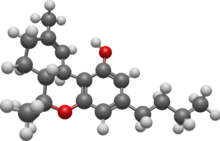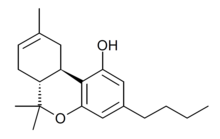Δ9-Tetrahydrocannabutol (tetrahydrocannabinol-C4, THC-C4, Δ9-THCB, (C4)-Δ9-THC, butyl-THC) is a phytocannabinoid found in cannabis that is a homologue of tetrahydrocannabinol (THC), the main active component of Cannabis.[1] Structurally, they are only different by the pentyl side chain being replaced by a butyl side chain. THCB was studied by Roger Adams as early as 1942 [2]
 | |
 | |
| Clinical data | |
|---|---|
| ATC code |
|
| Identifiers | |
| |
| CAS Number | |
| PubChem CID | |
| ChemSpider | |
| UNII | |
| ChEMBL | |
| CompTox Dashboard (EPA) | |
| Chemical and physical data | |
| Formula | C20H28O2 |
| Molar mass | 300.442 g·mol−1 |
| 3D model (JSmol) | |
| |
| |
| | |
Pharmacology
Δ9-THCB, showed an affinity for the human CB1 (Ki = 15 nM) and CB2 receptors (Ki = 51 nM) comparable to that of Δ9-THC.[1] The formalin test in vivo was performed on Δ9-THCB in order to reveal possible analgesic and anti-inflammatory properties.[1] The tetrad test in mice showed a partial agonistic activity of Δ9-THCB toward the CB1 receptor.[1] THCB has rarely been isolated from cannabis samples,[1][3] but appears to be less commonly present than THC or THCV. It is metabolized in a similar manner to THC.[4]
In an analysis by the University of Rhode Island on phytocannabinoids it was found that THC-Butyl had the highest 3C-like protease inhibitor activity against COVID-19 out of all the phytocannabinoids tested within that study but not as high as the antiviral drug GC376 (81% THCB vs. 100% GC376).[5]
Chemistry
Similarly to THC, it has 7 double bond isomers and 30 stereoisomers.[6] The Δ8 isomer is known as a synthetic cannabinoid under the code name JWH-130,[7] and the ring-opened analogue cannibidibutol (CBDB) is also known.[8] THC-Butyl can be synthesized from 4-butylresorcinol.[citation needed]


Legality
THCB is not scheduled internationally under the Convention on Psychotropic Substances, but may be controlled under analogue law in some individual jurisdictions as a homologue of THC.